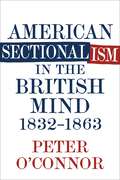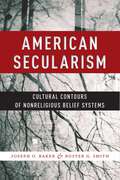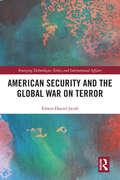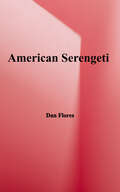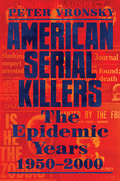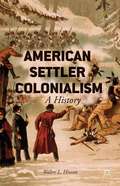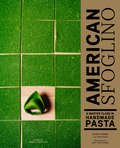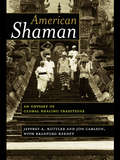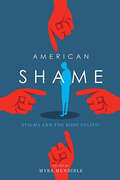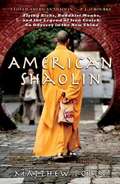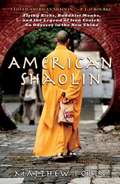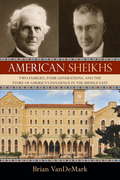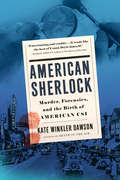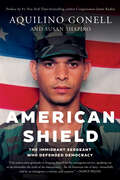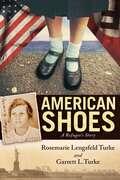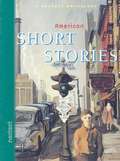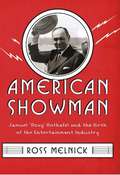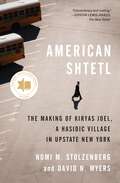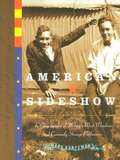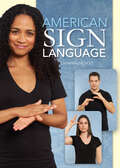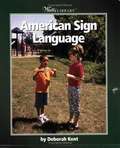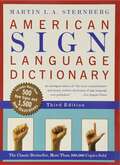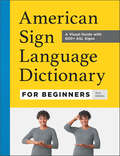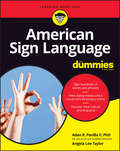- Table View
- List View
American Sectionalism in the British Mind, 1832-1863
by Peter O'ConnorIn American Sectionalism in the British Mind, 1832–1863, Peter O’Connor uses an innovative interdisciplinary approach to provide a corrective to simplified interpretations of British attitudes towards the United States during the antebellum and early Civil War periods. Exploring the many complexities of transatlantic politics and culture, O’Connor examines developing British ideas about U.S. sectionalism, from the abolition of slavery in the British Empire and the Nullification Crisis in South Carolina to the Civil War.Through a close reading of travelogues, fictional accounts, newspaper reports, and personal papers, O’Connor argues that the British literate population had a longstanding familiarity with U.S. sectionalism and with the complex identities of the North and South. As a consequence of their engagement with published accounts of America produced in the decades leading up to the Civil War, the British populace approached the conflict through these preexisting notions.O’Connor reveals even antislavery commentators tended to criticize slavery in the abstract and to highlight elements of the system that they believed compared favorably to the condition of free blacks in the North. As a result, the British saw slavery in the U.S. in national as opposed to sectional terms, which collapsed the moral division between North and South. O’Connor argues that the British identified three regions within America—the British Cavalier South, the British Puritan New England, and the ethnically heterogeneous New York and Pennsylvania region—and demonstrates how the apparent lack of a national American culture prepared Britons for the idea of disunity within the U.S. He then goes on to highlight how British commentators engaged with American debates over political culture, political policy, and states’ rights. In doing so, he reveals the complexity of the British understanding of American sectionalism in the antebellum era and its consequences for British public opinion during the Civil War.American Sectionalism in the British Mind, 1832–1863 re-conceptualizes our understanding of British engagements with the United States during the mid-nineteenth century, offering a new explanation of how the British understood America in the antebellum and Civil War eras.
American Secularism: Cultural Contours of Nonreligious Belief Systems (Religion and Social Transformation #3)
by Joseph O. Baker Buster G. SmithHonorable Mention, American Sociological Association Section on Religion Distinguished Book AwardA rapidly growing number of Americans are embracing life outside the bounds of organized religion. Although America has long been viewed as a fervently religious Christian nation, survey data shows that more and more Americans are identifying as “not religious.” There are more non-religious Americans than ever before, yet social scientists have not adequately studied or typologized secularities, and the lived reality of secular individuals in America has not been astutely analyzed. American Secularism documents how changes to American society have fueled these shifts in the non-religious landscape and examines the diverse and dynamic world of secular Americans.This volume offers a theoretical framework for understanding secularisms. It explores secular Americans’ thought and practice to understand secularisms as worldviews in their own right, not just as negations of religion. Drawing on empirical data, the authors examine how people live secular lives and make meaning outside of organized religion. Joseph O. Baker and Buster G. Smith link secularities to broader issues of social power and organization, providing an empirical and cultural perspective on the secular landscape. In so doing, they demonstrate that shifts in American secularism are reflective of changes in the political meanings of “religion” in American culture.American Secularism addresses the contemporary lived reality of secular individuals, outlining forms of secular identity and showing their connection to patterns of family formation, sexuality, and politics, providing scholars of religion with a more comprehensive understanding of worldviews that do not include traditional religion. Data Analyses Appendix
American Security and the Global War on Terror
by Edwin Daniel JacobThis book delivers an interpretive framework for making sense of today’s geopolitical landscape and casts new light on the impact ideology and technology have had on American foreign policy and contemporary security practices. Edwin Daniel Jacob argues that America’s security practices in the Global War on Terror have been guided by an anachronistic Cold War logic that has subordinated strategy to tactics. Jacob shows that deep-rooted prejudices and presuppositions regarding American exceptionalism have had a disastrous impact on the policies of the United States, not only in dealing with terrorism, but also in seeking to impose American hegemony in the Middle East. Ineffectual security practices of dubious moral character, from rendition and torture to preemptive strikes and nation building to drones and assassinations, privilege exigency over ethics. Yet the result of this "post-strategic" approach to security, where interchangeable tactics, like these, masquerade as strategy, only increases insecurity. Jacob offers a fresh perspective on American foreign policy that links national security with human security in regional terms. This approach highlights the need for order, predictability, and stability—the cornerstone of political realism. Making use of insights derived from Machiavelli, Hobbes, Marx, Weber, Schmitt, and Morgenthau, this interdisciplinary work provides an overview of American foreign policy in the twenty-first century and speaks to crucial themes in the fields of history, political science, and sociology.
American Serengeti: The Last Big Animals of the Great Plains
by Dan FloresAmerica's Great Plains once possessed one of the grandest wildlife spectacles of the world, equaled only by such places as the Serengeti, the Masai Mara, or the veld of South Africa. Pronghorn antelope, gray wolves, bison, coyotes, wild horses, and grizzly bears: less than two hundred years ago these creatures existed in such abundance that John James Audubon was moved to write, "it is impossible to describe or even conceive the vast multitudes of these animals." In a work that is at once a lyrical evocation of that lost splendor and a detailed natural history of these charismatic species of the historic Great Plains, veteran naturalist and outdoorsman Dan Flores draws a vivid portrait of each of these animals in their glory--and tells the harrowing story of what happened to them at the hands of market hunters and ranchers and ultimately a federal killing program in the nineteenth and twentieth centuries. The Great Plains with its wildlife intact dazzled Americans and Europeans alike, prompting numerous literary tributes. American Serengeti takes its place alongside these celebratory works, showing us the grazers and predators of the plains against the vast opalescent distances, the blue mountains shimmering on the horizon, the great rippling tracts of yellowed grasslands. Far from the empty "flyover country" of recent times, this landscape is alive with a complex ecology at least 20,000 years old--a continental patrimony whose wonders may not be entirely lost, as recent efforts hold out hope of partial restoration of these historic species. Written by an author who has done breakthrough work on the histories of several of these animals--including bison, wild horses, and coyotes--American Serengeti is as rigorous in its research as it is intimate in its sense of wonder--the most deeply informed, closely observed view we have of the Great Plains' wild heritage.
American Serial Killers: The Epidemic Years 1950-2000
by Peter VronskyFans of Mindhunter and true crime podcasts will devour these chilling stories of serial killers from the American "Golden Age" (1950-2000). With books like Serial Killers, Female Serial Killers and Sons of Cain, Peter Vronsky has established himself as the foremost expert on the history of serial killers. In this first definitive history of the "Golden Age" of American serial murder, when the number and body count of serial killers exploded, Vronsky tells the stories of the most unusual and prominent serial killings from the 1950s to the early twenty-first century. From Ted Bundy to the Golden State Killer, our fascination with these classic serial killers seems to grow by the day. American Serial Killers gives true crime junkies what they crave, with both perennial favorites (Ed Kemper, Jeffrey Dahmer) and lesser-known cases (Melvin Rees, Harvey Glatman).
American Settler Colonialism
by Walter L. Hixson 2013Over the course of three centuries, American settlers helped to create the richest, most powerful nation in human history, even as they killed and displaced millions. This groundbreaking work shows that American history is defined by settler colonialism, providing a compelling framework through which to understand its rise to global dominance.
American Sfoglino: A Master Class in Handmade Pasta
by Evan Funke Katie Parla*THE JAMES BEARD MEDIA AWARD WINNER FOR BEST PHOTOGRAPHY*"Evan Funke's respect for tradition and detail makes American Sfoglino the perfect introduction to the fresh egg pastas of Emilia Romagna. It's bold in its simplicity and focus." — Missy Robbins, chef/owner of Lilia and MISIForget your pasta machine and indulge in the magic of being a sfoglino with the help of the rich imagery and detailed instructions provided by Evan Funke and American Sfoglino.A comprehensive guide to making the best pasta in the world: In this debut cookbook from Evan Funke, he shares classic techniques from his Emilia Romagna training and provides accessible instructions for making his award winning sfoglia (sheet pasta) at home. With little more than flour, eggs, and a rolling pin, you too can be a sfoglino (a pasta maker) and create traditional Italian noodles that are perfectly paired with the right sauces.Features recipes for home cooks to recreate 15 classic pasta shapes, spanning simple pappardelle to perfect tortelloni.Beginning with four foundational doughs, American Sfoglino takes readers step by step through recipes for a variety of generous dishes, from essential sauces and broths, like Passata di Pomodoro (Tomato Sauce) and Brodo di Carne (Meat Broth) to luscious Tagliatelle in Bianco con Prosciutto (Tagliatelle with Bacon and Butter) and Lasagna Verde alla Bolognese (Green Bolognese Lasagna) in this treasure trove of a recipe book.Includes stories from Italy and the kitchen at Funke's Felix Trattoria that add the finishing touches to this pasta masterclass, while sumptuous James Beard-award winning photographs and a bold package offer a feast for the eyes.Evan Funke is a master pasta maker and the chef owner of Felix Trattoria in Venice, California. Katie Parla is a food writer and IACP award winning author whose work has appeared in numerous outlets, including the New York Times, Food & Wine, and Saveur. Eric Wolfinger is a James Beard Award winning food photographer.Makes an excellent gift idea for any pasta aficionado or avid Italian cook.
American Shaman: An Odyssey of Global Healing Traditions
by Jeffrey A. Kottler Jon Carlson Bradford KeeneyWritten for therapists, scholars, clergy, students, and those with an interest in non-traditional healing practices, this book tells the story of Bradford Keeney, the first non-African to be inducted as a shaman in the Kung Bushman and Zulu cultures.
American Shame: Stigma and the Body Politic
by Myra MendibleOn any given day in America's news cycle, stories and images of disgraced politicians and celebrities solicit our moral indignation, their misdeeds fueling a lucrative economy of shame and scandal. Shame is one of the most coercive, painful, and intriguing of human emotions. Only in recent years has interest in shame extended beyond a focus on the subjective experience of this emotion and its psychological effects. The essays collected here consider the role of shame as cultural practice and examine ways that public shaming practices enforce conformity and group coherence. Addressing abortion, mental illness, suicide, immigration, and body image among other issues, this volume calls attention to the ways shaming practices create and police social boundaries; how shaming speech is endorsed, judged, or challenged by various groups; and the distinct ways that shame is encoded and embodied in a nation that prides itself on individualism, diversity, and exceptionalism. Examining shame through a prism of race, sexuality, ethnicity, and gender, these provocative essays offer a broader understanding of how America's discourse of shame helps to define its people as citizens, spectators, consumers, and moral actors.
American Shaolin: An Odyssey in the New China
by Matthew PollyAutobiographical account of the author, who was the target of the bullies at school. He wanted to become a strong fighter and so attended the Shaolin temple in China where the martial arts are taught.
American Shaolin: Flying Kicks, Buddhist Monks, and the Legend of Iron Crotch: An Odyssey in theNe w China
by Matthew PollyMatthew Polly was your typical 98-pound weakling with sand kicked in his face - until he decided to learn to kick back. Dropping out of university, he travelled to China to study at the granddaddy of all Chinese martial arts monasteries: the Shaolin Temple, the birthplace of both Zen Buddhism and kungfu. But, as Confucius might have said, path to becoming kung fu master very difficult. For one thing, no one knew where exactly the Shaolin Temple was. And asking for directions proved problematic - after three years spent learning Mandarin in college, Matthew couldn't understand a word outside the classroom. He finally found the Shaolin village hidden away between five mountain peaks. But the hard part was yet to come. The Chinese term for tough training is chi ku (eating bitter) - and Matthew quickly leaned to appreciate the phrase. By the end of the second day of training his knees were in agony and he was walking like the dead - and that was just the induction. American Shaolin is the hilarious story of Matthew's remarkable two-year travel odyssey - a tale of gruelling training, forbidden romance and an eye-watering insight into the art of 'iron-crotch' kungfu.
American Sheikhs
by Brian VandemarkIn addition to their ability to overcome cultural barriers and think independently, the greatest minds in Middle Eastern politics and culture share a common background: they graduated from the American University of Beirut. AUB graduates, whose lives and accomplishments played a significant role in much of the modern history in this critical region of the world, include countless leaders, legislators, ambassadors, educators, scientists, doctors, and businesspeople. Persons such as philosopher and diplomat Charles Malik; Lebanon's former prime minister Fouad Siniora; Arab League ambassador to France Nasif Hitti; and Rula Dashti, one of the first four women to win a seat in Kuwait's House of Parliament, are just a few of the exemplary alumni who embody the ideals of the AUB.In 1866, American missionaries founded a small college in Beirut, Lebanon, called the Syrian Protestant College. Later renamed the American University of Beirut, what began as a humble missionary school grew to become the most influential institution of higher education in the Middle East. Originally created by Reverend Daniel Bliss with the financial backing of businessman William E. Dodge, the AUB, under the leadership of four generations of the Bliss and Dodge families, became the preeminent symbol of American culture and values in the Middle East. This author's vivid narrative not only includes the colorful history of the AUB and many memorable episodes in a dual family saga but also pursues larger and more important themes. In the story of the efforts of these two families to build a great school with alternating audacity, arrogance, generosity, paternalism, and vision, the author clearly sees an allegory for the larger history of the United States in the Middle East.With the ideas of American nationalism and presumptions of Manifest Destiny, arrogant missionaries came to the Middle East in the nineteenth century looking to convert Muslims to Christianity. Through hard experience, these Americans learned to engage Middle Easterners on their own terms--by teaching them, rather than preaching to them. With that, the AUB shifted its focus from religious conversion to educational enlightenment and independent thinking. In doing so, both men and women, whether they be Muslim, Jew, or Christian, generally viewed the school as an engine of constructive change and the United States as a benign force in the region. Long before conflicts over oil, the state of Israel, and military intervention became the prevalent motifs of US involvement in the region, Americans and Middle Easterners encountered one another, learned to work together, and came to understand one another because the AUB served as neutral ground where tolerance and mutual respect prevailed.But in the post-World War II era, with the rise of America as a world power, the AUB found itself buffeted by the strong winds of nationalist frustration, Zionism and anti-Zionism, and eventually Islamic extremism. Middle Easterners became more ambivalent about America's purposes and began to perceive the university not just as a cradle of learning but also as an agent of undesirable Western interests. Despite the tumultuous atmosphere of civil war in Lebanon, foreign invasions throughout the Middle East, and daily riots and bombings in Beirut, the AUB remained intact, holding fast to the ideals of intercultural engagement and mutual regard for diverse points of view.This story is full of meaning today. By revealing how and why the Blisses and Dodges both succeeded and failed in their attempts to influence the Middle East, the author shows how America's outreach in the region can be improved, and he explains the vital importance of maintaining good relations between Americans and the Muslim world in the new century. AThis book tells the story of America giving to, rather than taking from, the nations and peoples of this vitally important yet volatile area. It is a model for how Americans and Middle Easterners of all faiths and perspectives can learn to work together.
American Sherlock: Murder, Forensics, and the Birth of American CSI
by Kate Winkler DawsonFrom the acclaimed author of Death in the Air ("Not since Devil in the White City has a book told such a harrowing tale"--Douglas Preston) comes the riveting story of the birth of criminal investigation in the twentieth century.Berkeley, California, 1933. In a lab filled with curiosities--beakers, microscopes, Bunsen burners, and hundreds upon hundreds of books--sat an investigator who would go on to crack at least two thousand cases in his forty-year career. Known as the "American Sherlock Holmes," Edward Oscar Heinrich was one of America's greatest--and first--forensic scientists, with an uncanny knack for finding clues, establishing evidence, and deducing answers with a skill that seemed almost supernatural.Heinrich was one of the nation's first expert witnesses, working in a time when the turmoil of Prohibition led to sensationalized crime reporting and only a small, systematic study of evidence. However with his brilliance, and commanding presence in both the courtroom and at crime scenes, Heinrich spearheaded the invention of a myriad of new forensic tools that police still use today, including blood spatter analysis, ballistics, lie-detector tests, and the use of fingerprints as courtroom evidence. His work, though not without its serious--some would say fatal--flaws, changed the course of American criminal investigation. Based on years of research and thousands of never-before-published primary source materials, American Sherlock captures the life of the man who pioneered the science our legal system now relies upon--as well as the limits of those techniques and the very human experts who wield them.
American Shield: The Immigrant Sergeant Who Defended Democracy
by Susan Shapiro Aquilino Gonell&“American Shield is an all-American tale of duty and determination—beautifully told by an immigrant, a veteran, and a patriot.&” —Nancy Pelosi, Speaker Emerita of the United States House of RepresentativesSet against the extraordinary events of January 6, 2021, Aquilino Gonell&’s inspirational memoir is rooted in the joys and struggles of the immigrant experience that have long defined the American experimentAquilino Gonell came to the United States from the Dominican Republic as a young boy. Although he spoke no English, he dedicated himself to his adopted land, striving for the American dream. Determined to be a success story, he joined the army to pay for college. He saw action in Iraq and returned home with PTSD. Believing in the promise of our government, he focused on healing himself and supporting his family. His hard work paid off when he landed a coveted position with the United States Capitol Police and rose to the rank of sergeant.January 6, 2021, changed everything. When insurrectionists stormed the Capitol, Gonell bravely faced down the mob attempting to thwart the peaceful transfer of power. The brutal injuries he sustained that day would end his career in law enforcement. But when some of the very people he put his life on the line to protect downplayed or denied the truth of that day, he chose to speak out against the injustice done to him and the country. Chronicling what it means to live a life of conviction, one that adheres to the best ideas of our democracy, American Shield is a bold testament to the power of truth, justice, and accountability from a highly decorated officer and immigrant who exemplifies the greatest aspirations of a grateful nation.
American Shoes: A Refugee's Story
by Rosemarie Lengsfeld Turke Garrett TurkeCompiling countless hours of painstaking research, American Shoes is a profound mosaic of memories recounting 15-year-old Rosemarie Lengsfeld Turke&’s escape from Nazi Germany, leaving her life and family behind to forge ahead in an America she left as a small child.Set against a backdrop of Adolf Hitler&’s rise to power, the reign of Nazi Germany, and the entire course of World War II in Europe, American Shoes recounts the tumultuous childhood of a young American girl and her family trapped within a country that turned against itself, where human decency eroded and then vaporized. Forced to grow up in the midst of endemic fear stoked by a ravenous madman, American Shoes portrays the breakdown of a society from a child&’s point of view, deep inside a land where millions of law-abiding citizens were targeted as threats, and then removed for extermination. This is the story of a brave girl who, despite not being Jewish, was perceived to be one of those threats and was compelled to keep her American identity secret for fear of her family&’s arrest, concentration camp placement, or worse. Fighting to see through a relentless barrage of Nazi lies and propaganda, caught within a nation where resistance or opposition meant incarceration if not certain death, American Shoes illuminates one family&’s struggle to survive against impossible odds as a cataclysmic world war marched closer and closer until it was upon them. Vividly told for the first time after seven decades of a family&’s collective silence, American Shoes reveals the story of a brave and spirited young girl named Rosel who refused to accept the new order of a world gone mad, inside a society that became more sinister and macabre than any childhood nightmare could ever be. Driven by the faint memories of the land where she was born—a hazy beacon that guided her toward freedom and a new life—this is the story of Rosemarie Lengsfeld Turke.
American Short Stories
by Mcdougal LittellThe American short stories presented in the book are grouped under the following sections : Romanticism and Realism,The Birth of the Modern,Building a Tradition,New Voices and Identities.
American Short Stories (Second Edition)
by Perfection Learning Editorial StaffThis collection of short stories introduces you to some of America's most important writers though you may not like every one, but each author has a unique message to send and a distinctive way of sending it.
American Showman: Samuel "Roxy" Rothafel and the Birth of the Entertainment Industry, 1908–1935 (Film and Culture Series)
by Ross MelnickSamuel "Roxy" Rothafel (1882–1936) built an influential and prolific career as film exhibitor, stage producer, radio broadcaster, musical arranger, theater manager, war propagandist, and international celebrity. He helped engineer the integration of film, music, and live performance in silent film exhibition; scored early Fox Movietone films such as Sunrise (1927); pioneered the convergence of film, broadcasting, and music publishing and recording in the 1920s; and helped movies and moviegoing become the dominant form of mass entertainment between the world wars. <P><P>The first book devoted to Rothafel's multifaceted career, American Showman examines his role as the key purveyor of a new film exhibition aesthetic that appropriated legitimate theater, opera, ballet, and classical music to attract multi-class audiences. Roxy scored motion pictures, produced enormous stage shows, managed many of New York's most important movie houses, directed and/or edited propaganda films for the American war effort, produced short and feature-length films, exhibited foreign, documentary, independent, and avant-garde motion pictures, and expanded the conception of mainstream, commercial cinema. He was also one of the chief creators of the radio variety program, pioneering radio broadcasting, promotions, and tours.The producers and promoters of distinct themes and styles, showmen like Roxy profoundly remade the moviegoing experience, turning the deluxe motion picture theater into a venue for exhibiting and producing live and recorded entertainment. Roxy's interest in media convergence also reflects a larger moment in which the entertainment industry began to create brands and franchises, exploit them through content release "events," and give rise to feature films, soundtracks, broadcasts, live performances, and related consumer products. Regularly cited as one of the twelve most important figures in the film and radio industries, Roxy was instrumental to the development of film exhibition and commercial broadcasting, musical accompaniment, and a new, convergent entertainment industry.
American Shtetl: The Making of Kiryas Joel, a Hasidic Village in Upstate New York
by David N. Myers Nomi M. StolzenbergA compelling account of how a group of Hasidic Jews established its own local government on American soilSettled in the mid-1970s by a small contingent of Hasidic families, Kiryas Joel is an American town with few parallels in Jewish history—but many precedents among religious communities in the United States. This book tells the story of how this group of pious, Yiddish-speaking Jews has grown to become a thriving insular enclave and a powerful local government in upstate New York. While rejecting the norms of mainstream American society, Kiryas Joel has been stunningly successful in creating a world apart by using the very instruments of secular political and legal power that it disavows.Nomi Stolzenberg and David Myers paint a richly textured portrait of daily life in Kiryas Joel, exploring the community's guiding religious, social, and economic norms. They delve into the roots of Satmar Hasidism and its charismatic founder, Rebbe Joel Teitelbaum, following his journey from nineteenth-century Hungary to post–World War II Brooklyn, where he dreamed of founding an ideal Jewish town modeled on the shtetls of eastern Europe. Stolzenberg and Myers chart the rise of Kiryas Joel as an official municipality with its own elected local government. They show how constant legal and political battles defined and even bolstered the community, whose very success has coincided with the rise of political conservatism and multiculturalism in American society over the past forty years.Timely and accessible, American Shtetl unravels the strands of cultural and legal conflict that gave rise to one of the most vibrant religious communities in America, and reveals a way of life shaped by both self-segregation and unwitting assimilation.
American Sideshow: An Encyclopedia Of History's Most Wondrous And Curiously Strange Performers
by Marc HartzmanA fascinating look into the history of the American sideshow and its performers. Learn what's real, what's fake, and what's just downright bizarre. You've probably heard of Tom Thumb. The Elephant Man. Perhaps even Chang and Eng, the original Siamese twins. But what about Eli Bowen, the legless acrobat? Or Prince Randian, the human torso? These were just a few of the many stars that shone during the heyday of the American sideshow, from 1840 to 1950. American Sideshowchronicles the lives of truly amazing performers, examining these brave and extraordinary curiosities not just as sideshow performers but as people, delving into the lives they led and the ways they were able to triumph over and even benefit from their abnormalities. American Sideshowdiscusses the rise and fall of the original sideshows and their subsequent replacement by today's self-made freaks. With the progress of modern medicine, technological advancements, and the wonderful world of body modification, abnormalities are being overcome, treated and even prevented: Siamese twins can now be separated, and in addition to this, tongues can be forked, horns surgically implanted, and earlobes removed. There are also, of course, modern-day giants, fire eaters, sword swallowers, glass eaters, human blockheads, and oh, so much more. These fascinating personalities are celebrated through intimate biographies paired with stunning photographs. Approximately two hundred performers from the past one hundred and sixty years are featured, giving readers a comprehensive and sometimes astonishing look into the history of the American sideshow
American Sign Language
by Catherine NicholsIt's the third most used language in the United States-and yet it's "spoken" without even opening your mouth! It's estimated that as many as two million Americans speak American Sign Language, a method of communication that's both fun and useful, even if you or your friends and family are not hearing impaired.American Sign Language uses simple-to-follow photographs to teach you the alphabet, numbers, and simple words and phrases. Divided into categories such as Animals and People and Pronouns, the book and accompanying flashcards show you how to use your hands to communicate. Once you've learned the alphabet, you'll build on that knowledge to learn the words for "friend" and "family." And when you how the words for "chicken" and "cat" evoke a chicken opening and closing its beak and a cat stroking its whiskers, you'll truly understand how intuitive and enjoyable learning American Sign Language can be.Learning a new language is always a rewarding endeavor-and with American Sign Language, it's easier than ever!
American Sign Language
by Deborah KentThis book gives young readers a brief overview of American Sign Language (ASL). The book focuses on the history of ASL and the controversies which have surrounded it since its inception.
American Sign Language Dictionary
by Martin L. SternbergDeaf since the age of seven, Martin L. A. Sternberg, Ed.D., spent most of his career working with deaf people. Inspired by his sign language teacher at Gallaudet University in Washington, DC, he devised this vital reference to help anyone learn to speak with their hands. <p><p>A must for parents, instructors, and students, American Sign Language Dictionary includes everything you need to know to communicate clearly using ASL. This illustrated abridgment of the most authoritative reference book on sign language features more than 5,000 signs and 8,000 illustrations, as well as clear, detailed instructions to help you master each sign.
American Sign Language Dictionary for Beginners: A Visual Guide with 800+ ASL Signs
by Tara AdamsA user-friendly dictionary with 800+ ASL signs Whatever your reason for learning the richly expressive language of American Sign Language (ASL), this book will guide you through the initial stages of your signing journey. It's filled with everything you need to master more than 800 essential vocabulary words, including detailed directions that make it simple to develop your ASL skills.What sets this dictionary apart from other sign language books for beginners:No experience required—Find comprehensive, clearly written guidance that makes sense of American Sign Language for beginners, with helpful explanations of more difficult concepts, plus plenty of tips for success.Instructional photographs—See ASL in action with full-color photographs that illustrate how to sign each vocabulary word.Easy-to-find signs—Study each sign in alphabetical order or search by category with a handy index that organizes signs by activities, animals, emotions, places, events, and more.Build up your ASL vocabulary with the American Sign Language Dictionary for Beginners.
American Sign Language For Dummies
by Angela Lee Taylor Adan R. Penilla IIGrasp the rich culture and language of the Deaf community To see people use American Sign Language (ASL) to share ideas is remarkable and fascinating to watch. Now, you have a chance to enter the wonderful world of sign language. American Sign Language For Dummies offers you an easy-to-access introduction so you can get your hands wet with ASL, whether you're new to the language or looking for a great refresher. Used predominantly in the United States, ASL provides the Deaf community with the ability to acquire and develop language and communication skills by utilizing facial expressions and body movements to convey and process linguistic information. With American Sign Language For Dummies, the complex visual-spatial and linguistic principles that form the basis for ASL are broken down, making this a great resource for friends, colleagues, students, education personnel, and parents of Deaf children. Grasp the various ways ASL is communicated Get up to speed on the latest technological advancements assisting the Deaf Understand how cultural background and regionalism can affect communication Practice signing with videos online If you want to get acquainted with Deaf culture and understand what it's like to be part of a special community with a unique shared and celebrated history and language, American Sign Language For Dummies gets you up to speed on ASL fast.
